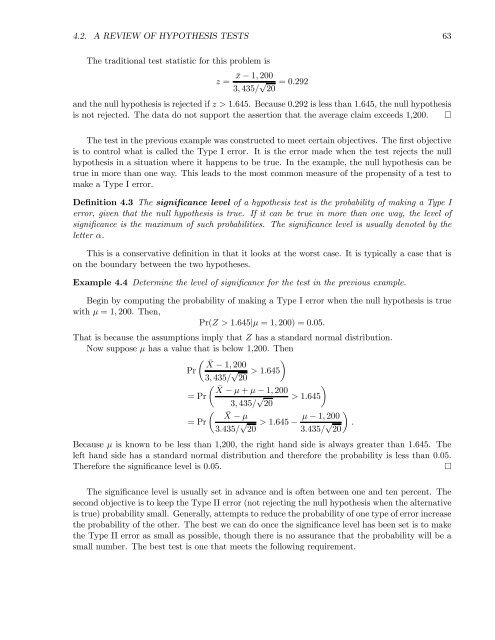Estimation, Evaluation, and Selection of Actuarial Models
Estimation, Evaluation, and Selection of Actuarial Models
Estimation, Evaluation, and Selection of Actuarial Models
Create successful ePaper yourself
Turn your PDF publications into a flip-book with our unique Google optimized e-Paper software.
4.2. A REVIEW OF HYPOTHESIS TESTS 63<br />
The traditional test statistic for this problem is<br />
¯x − 1, 200<br />
z =<br />
3, 435/ √ 20 =0.292<br />
<strong>and</strong> the null hypothesis is rejected if z>1.645. Because 0.292 is less than 1.645, the null hypothesis<br />
is not rejected. The data do not support the assertion that the average claim exceeds 1,200. ¤<br />
The test in the previous example was constructed to meet certain objectives. The first objective<br />
is to control what is called the Type I error. It is the error made when the test rejects the null<br />
hypothesis in a situation where it happens to be true. In the example, the null hypothesis can be<br />
true in more than one way. This leads to the most common measure <strong>of</strong> the propensity <strong>of</strong> a test to<br />
make a Type I error.<br />
Definition 4.3 The significance level <strong>of</strong> a hypothesis test is the probability <strong>of</strong> making a Type I<br />
error, given that the null hypothesis is true. If it can be true in more than one way, the level <strong>of</strong><br />
significance is the maximum <strong>of</strong> such probabilities. The significance level is usually denoted by the<br />
letter α.<br />
This is a conservative definition in that it looks at the worst case. It is typically a case that is<br />
on the boundary between the two hypotheses.<br />
Example 4.4 Determine the level <strong>of</strong> significance for the test in the previous example.<br />
Begin by computing the probability <strong>of</strong> making a Type I error when the null hypothesis is true<br />
with µ =1, 200. Then,<br />
Pr(Z >1.645|µ =1, 200) = 0.05.<br />
That is because the assumptions imply that Z has a st<strong>and</strong>ard normal distribution.<br />
Now suppose µ has a value that is below 1,200. Then<br />
µ <br />
¯X − 1, 200<br />
Pr<br />
3, 435/ √ 20 > 1.645 µ <br />
¯X − µ + µ − 1, 200<br />
=Pr<br />
3, 435/ √ > 1.645<br />
20<br />
µ <br />
¯X − µ<br />
=Pr<br />
3.435/ √ µ − 1, 200<br />
> 1.645 −<br />
20 3.435/ √ .<br />
20<br />
Because µ is known to be less than 1,200, the right h<strong>and</strong> side is always greater than 1.645. The<br />
left h<strong>and</strong> side has a st<strong>and</strong>ard normal distribution <strong>and</strong> therefore the probability is less than 0.05.<br />
Therefore the significance level is 0.05. ¤<br />
The significance level is usually set in advance <strong>and</strong> is <strong>of</strong>ten between one <strong>and</strong> ten percent. The<br />
second objective is to keep the Type II error (not rejecting the null hypothesis when the alternative<br />
is true) probability small. Generally, attempts to reduce the probability <strong>of</strong> one type <strong>of</strong> error increase<br />
the probability <strong>of</strong> the other. The best we can do once the significance level has been set is to make<br />
the Type II error as small as possible, though there is no assurance that the probability will be a<br />
small number. The best test is one that meets the following requirement.
















